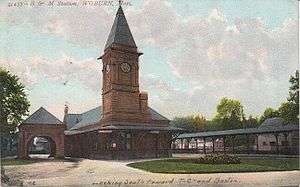Woburn station (1844–1981)
Woburn is a former railroad station on the Woburn Branch (formerly the Woburn Loop), part of the Massachusetts Bay Transportation Authority's Lowell Line.
Woburn | |||||||||||
|---|---|---|---|---|---|---|---|---|---|---|---|
 1908 postcard of Woburn station | |||||||||||
| Location | Pleasant Street at Woburn Common (until 1959) Main Street at Summer Street (1959–1981) Woburn, Massachusetts | ||||||||||
| Coordinates | 42.47885°N 71.152748°W (until 1959) 42.476784°N 71.149932°W (1959–1981) | ||||||||||
| Owned by | Massachusetts Bay Transportation Authority | ||||||||||
| Line(s) | Woburn Branch | ||||||||||
| Platforms | 2[1] | ||||||||||
| Tracks | 2 | ||||||||||
| Other information | |||||||||||
| Fare zone | 2[2] | ||||||||||
| History | |||||||||||
| Opened | 1844 | ||||||||||
| Closed | 1981[3] | ||||||||||
| Services | |||||||||||
| |||||||||||
History
It was closed in 1981 when service on the Woburn Branch was terminated due to poor track conditions and insufficient funding;[4][5][6][7] service north of Woburn station had already been discontinued in June 1959.[6]
After the closure of the Woburn Branch, all trains travelling outbound from North Station on the Lowell Line simply stayed on the main line all the way north to Lowell. The only station on the Lowell Line left in Woburn was Mishawum, a low-capacity station that was only meant to serve the sparsely-populated northern neighborhoods of Woburn. The need for a larger station in the city quickly became apparent, so in 2001, the Anderson Regional Transportation Center, signed on MBTA maps as "Anderson/Woburn," was opened. Today, Anderson RTC is the MBTA station with the second-highest number of daily train departures outside of downtown Boston (30), and serves both the Lowell and Haverhill lines, as well as Amtrak trains on the Downeaster service.
Although the northern part of the Woburn Branch within the town of Wilmington (about a mile in length) is still used as an industrial spur to service customers along the line in South Wilmington, and the right-of-way of the entire branch is still owned by the MBTA, the part of the branch within Woburn is abandoned, the original Woburn station destroyed, and the little track remaining deteriorated to the point of being unsafe for any trains to use them without replacement.
References
- Massachusetts Public Service Commission (1920). Annual Report of the Public Service Commission, Volume 1. Wright and Potter Printing Co. Retrieved 8 June 2015.
- Daniel Lampariello (2011-12-24). "Commuter Rail to New Hampshire". bostontoat.blogspot.com. Retrieved 2015-06-08.
- Belcher, Jonathan. "Changes to Transit Service in the MBTA district" (PDF). NETransit.
- Karr, Ronald D. (1995). The Rail Lines of Southern New England - A Handbook of Railroad History. Branch Line Press. ISBN 0-942147-02-2.
- Karr, Ronald D. (1994). Lost Railroads New England. Branch Line Press. ISBN 0-942147-04-9.
- Humphrey, Thomas J. & Clark, Norton D. (1985). Boston's Commuter Rail: The First 150 Years. Boston Street Railway Association. pp. 17, 55–70. ISBN 9780685412947.
- "T changes start today". Boston Globe. February 1, 1981. p. 24 – via Newspapers.com.
